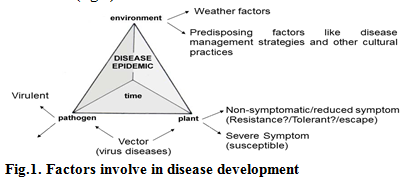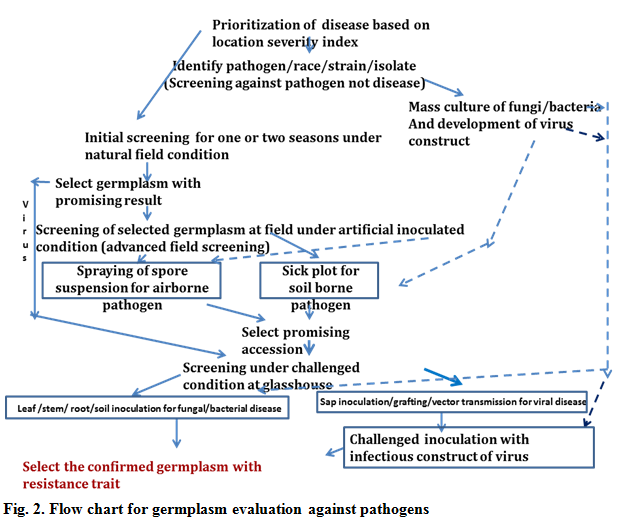Authors: Manas Kumar Bag 1, Anirban Roy2
1ICAR- National Rice Research Institute, Cuttack, 753 006, India
2ICAR - Indian Agricultural Research Institute, New Delhi, 110 012, India
*E-mail: manas.bag@gmail.com
One of the main objectives of evaluation of germplasm is identifying resistance donor to pathogen and utilization of that genetic factor to improve and protect crop production. Germplasm are the main sources for incorporating the trait of target in the cultivated varieties. Along with climate change and population explosion, we demand more from agriculture. Under such situations germplasm of crops, withstand better under biotic and abiotic pressures, are the keys for sustainability in agriculture. Genes of desirable traits are available in landraces and wild species. Screening of germplasm to identify resistant sources against biotic stresses is very much essential to support crop improvement programmes. A host is considered resistant when it has the ability to exclude, hinder or overcome the effects of a given pathogen or other damaging factor. A plant may be resistant to one pathogen or pest but not others. Often true resistance is not observed rather tolerance is more common phenomenon in host-pathogen interaction.
The success of the identification of resistant/tolerant germplasm will depend upon the methodology which has been adopted to screen such trait specific germplasm. Some guidelines are provided below to understand how the screening procedures need to be developed for identification of resistant sources against biotic stresses.
Important points to consider before screening:
♦ Number of stresses to be evaluated must be prioritized and taken one into consideration at a time.
♦ Evaluation of germplasm against biotic stress means evaluation against the pathogen not against the disease because the related disease symptom may be produced by another pathogen. So, it is essential to identify the pathogen based on morphological or molecular tools. Then, mass culture of identified pathogen needs to be done. In case of viruses, infectious viral construct needs to be prepared for challenge inoculation purpose.
♦ Identification of the pathogen is also important to know the race/strain/isolate/biotype which exists at that particular location.
Screening of germplasm for resistance to pathogens causing diseases:
Evaluation of germplasm of any crop against diseases is very crucial as expression of diseases and variability of their degree of expression not only depends upon the germplasm but also depends upon virulence of pathogen, the environmental conditions which include weather factors that affects survival of the pathogen as well as interaction between the host and the pathogen and adequate time which allow a pathogen to infect a host plant. These four factors i.e. susceptible host, virulent pathogen, environment and time, which cause disease is called “disease quadrangle”. In case of virus diseases often another factor, “vector”, which transmits virus is important to establish a disease (Fig. 1). Furthermore, different disease management strategies and other cultural practices may either prevent or predispose any hosts against diseases. So, non-occurrence of symptoms in any germplasm accession or reduced symptom production in any accession does not always imply resistance or tolerance of those germplasm, rather there may be chances of escape from the infection. Under these circumstances, repeated field screening with proper experimental design followed by stringent screening under artificial challenged inoculation condition under field and glasshouse are essential to establish a real resistance or tolerance response of germplasm.
(i) Field Screening:
(a) Preliminary field screening
♦ It should be done for one year with large number of accessions to narrow down the numbers to a manageable extent.
♦ For such purpose only percent disease incidence should be recorded and field tolerant accessions (<20% incidence) are selected.
(b) Advanced field screening
♦ Advance field screening of the selected field tolerant accessions should be done atleast two years.
♦ The advance screening plot and germplasm maintenance plot should be different. In advance screening plot no plant protection measures are adopted so that the germplasm should be exposed to the maximum load of inoculum pressure of pathogen or vectors of viruses.
♦ All the experiments should be done in replicated trials with susceptible check that can serve as infector row, preferably one line of infector row after every three lines of germplasm. The data should be recorded at regular intervals.
♦ There should be border lines of susceptible check from all the directions to facilitate spread of the disease infestation.
♦ For recording of the data on fungal and bacterial foliar diseases, standard evaluation system (SES) scale should be followed
♦ For recording of the data on viral diseases, incidence (No. of plant showing symptom over total No. of plant) and average disease severity (No. of leaves showing symptom or area covered over total No. of leaves in a single plant and averaged from atleast 5 plants) should be taken into account. A severity index grade should be formulated for individual disease based on the progress of the disease and coefficient of infection (CI) should be calculated using the formula : CI=% disease incidence (PDI) X Response value (severity grade). As per the CI value, a scale should be prepared and the response of the germplasm is categorized. The area under disease progress curve (AUDPC) value should be calculated to understand the rate of spread of the disease. The germplasm with low CI and AUDPC value should be selected as promising accession.
♦ For soil borne pathogen the selected germplasm should be grown in sick plot which should be maintained with optimum inoculum load. The susceptible check should show atleast 80-100% infection to confirm the optimum inoculum load.
♦ For air-borne pathogen, there should be spraying of spore suspension of the pathogen at regular intervals. In this case also, the susceptible check should show atleast 80-100% infection to confirm the optimum inoculum load.
(ii) Screening through challenged inoculation under greenhouse condition:
♦ For virus and other vector borne pathogens, advance screening under natural field condition are carried out for two years and the promising accessions are challenged under controlled glasshouse conditions with viruliferous insects (for insect transmited virus), sap from the infected plant (for mechanically transmitted virus) and grafting (for the viruses transmitted by vegetative propagules).
♦ Artificial inoculation under controlled conditions should also be carried out for fungal and bacterial pathogens. For such experiments advanced facilities like temperature humidity controlled glasshouse, insect maintenance chamber, plant inoculation chamber etc are essentially required.
♦ Finally, the identified accessions may be tested under multi-location evaluation at hot-spot to evaluate its performance against other race/strain/isolate of the pathogens those exist in different locations.
Method of germplasm evaluation against pathogen causing disease are summarized in the flow chart (fig.2).


About Author / Additional Info:
Scientist having expertise in evaluation of germplasm against plant pathogen, presently working on rice pathology specially post flowering diseases like false smut etc.